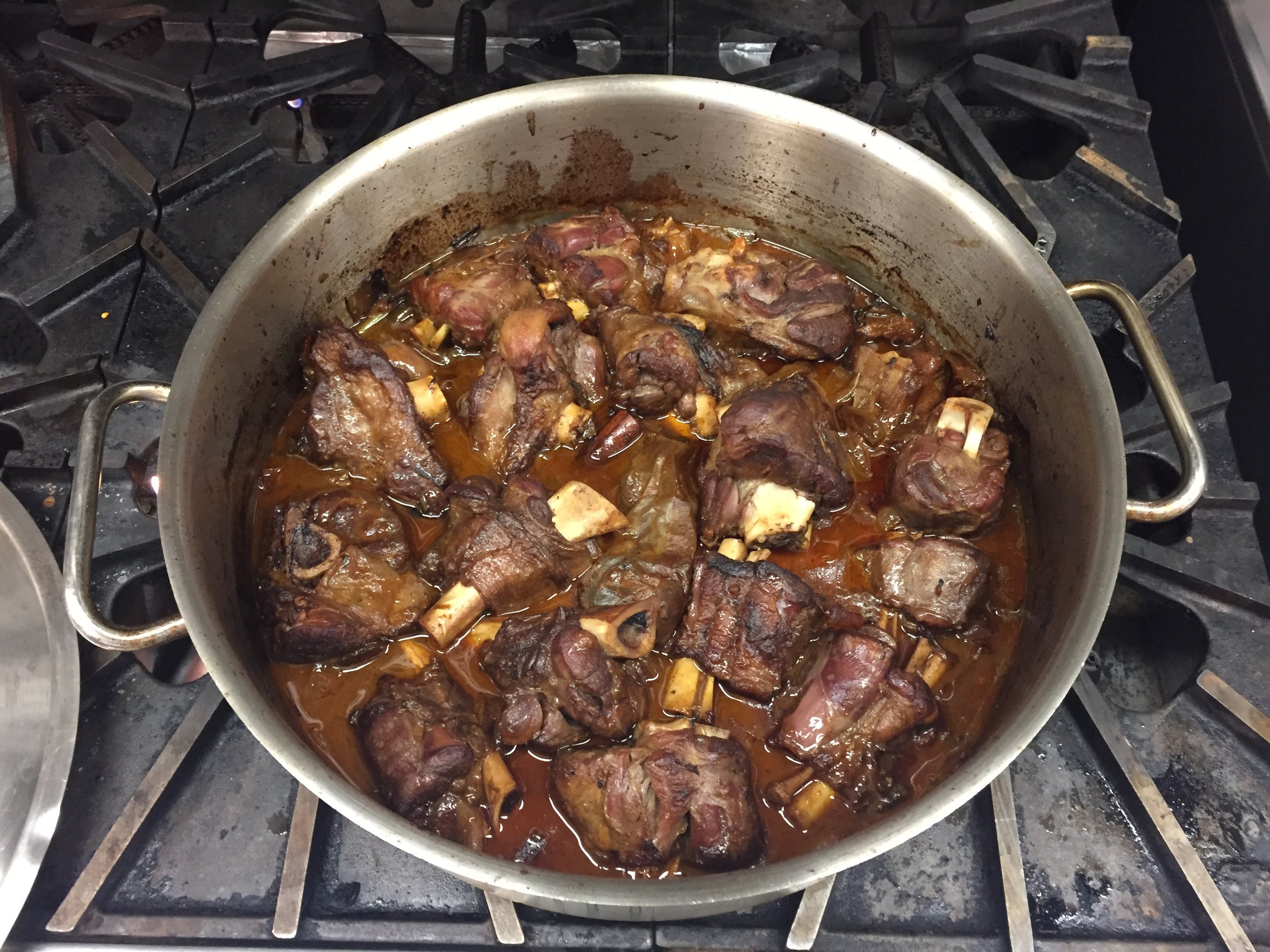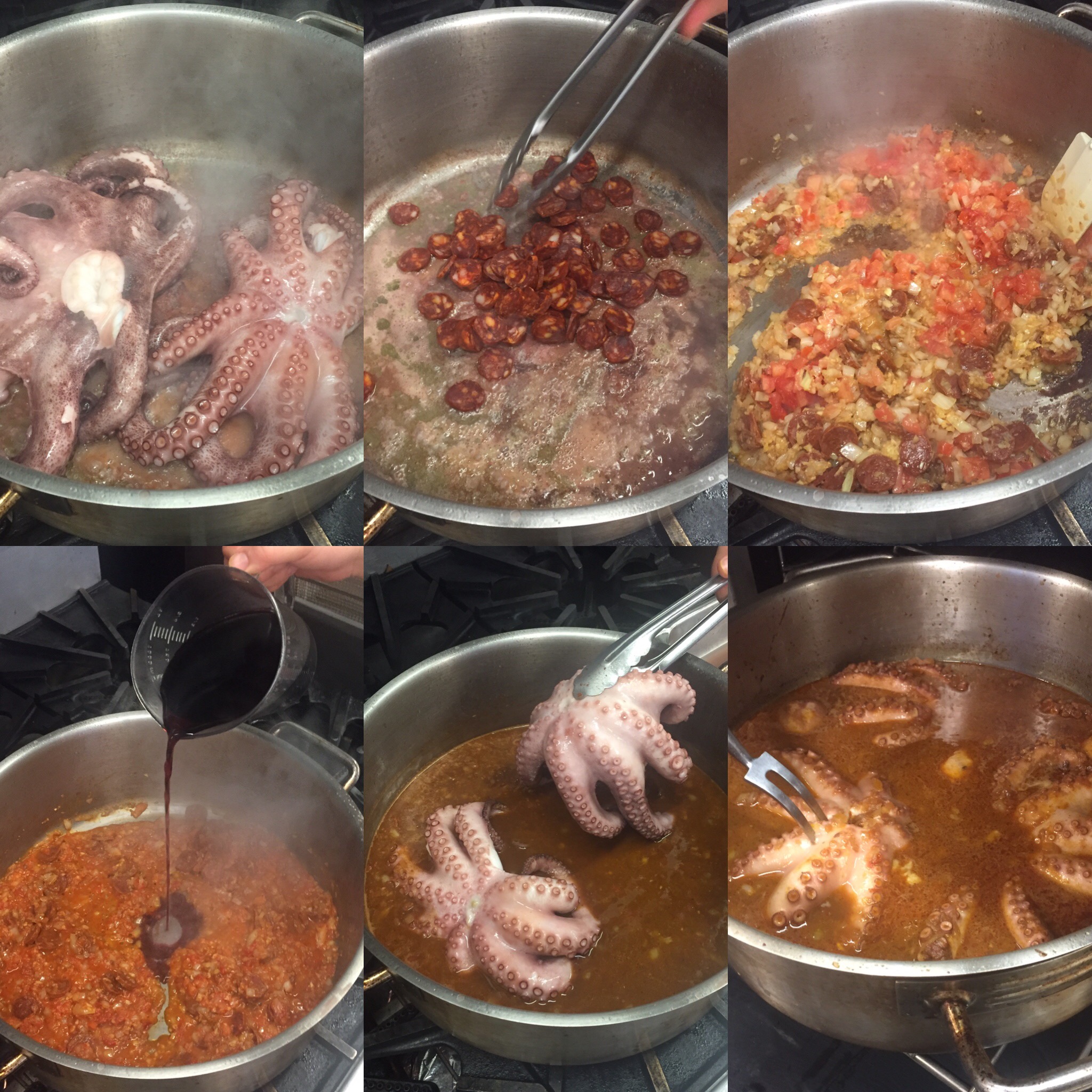Braises & Stews
Braises and stews are known as combination cooking methods, because they are started by pan searing in fats, which is a dry heat method, but finished by simmering in liquids. Suitable cuts for cooking in this style include beef, lamb, or pork shoulder, belly cuts including pork bacon, beef brisket, or veal breast. Leg cuts from lamb or beef are also used but tend to be drier requiring brining or larding to add juiciness. Leg cuts from chicken and other game birds are fitting. Fish and seafood are also used but generally are cooked for much less time because of their delicate nature. Let's not forget that a braise or stew can also be prepared with vegetables or other ingredients including tofu.
The slow cooking process used for braises and stews helps to tenderize the tougher muscle fibers of these cuts, while at the same time keeping them moist through added liquids. Accented with aromatic vegetables, seasonings, and liquids including wine, or spirits, and stock or prepared sauces, and these dishes are full of flavor and deeply satisfying.
Though the method is similar for braises and stews, there are some differences. A braise refers to larger cuts of meat, poultry, fish, and shellfish, seared on the stove and then covered and cooked slowly in an oven. Stews are portioned in cubes or strips with similar ingredients as a braise, but are finished either in an oven or on the stove. A braise uses less liquid than a stew, liquid is added to about one-third of the height of the braised items. A stew on the contrary is covered with liquid. This is because the smaller sized pieces will dry out quickly during the process if not submerged in liquid to keep them moist.
A stew is cooked with aromatic garnishes which are served together in the sauce, for example an Irish stew with diced carrots and potatoes, or a French coq au vin with mushrooms, pearl onions, and pork lardons. A braise however, is cooked with aromatics, which are strained out of the sauce, and a separate garnish is prepared and served to accompany it. For example, a German sauerbraten, brined and braised beef bottom round served with red cabbage and potato dumplings; or an Italian osso buco, cross-cut veal shanks garnished with risotto and gremolata (a green sauce of capers, parsley, lemon zest, olives and olive oil).
Braises include classic dishes such as a French fricassee, a white stew prepared with white wine, veloute sauce, and cream; an Indian lamb curry, prepared with ginger, garam masala, yogurt, and mint; or a Louisiana gumbo prepared with dark roux, a cajun trinity (onions, celery, and green peppers), and andouille sausage.
Variations
White stews and braises are prepared with lighter meats, poultry, veal, and fish searing the proteins and vegetables without browning them. White wine, white stock, and cream are often used in the preparation. Brown stews and braises use red meats, poultry, veal, and game and usually are caramelized in fat as a way to develop a rich color and flavor. Red wine, brown stock and tomatoes are added to further enhance the complexity of the dish. Traditionally braises and stews are slow methods for cooking tough cuts of meats and poultry that can often take hours to complete. Adapting these methods for fish and seafood requires the cooking time to be shortened dramatically so the food is not overcooked.
Ratios for Braises & Stews
A basic ratio for braises and stews is 10 parts of the main item, such as lamb shoulder or beef stew meat, 1 part aromatics such as a mirepoix, garlic, or peppers, and 2 parts liquid including wine or other spirits, and stock or prepared sauce. An easy way to remember the ratio is for every 10 lb./ 4.5 kg of the main item, add 1 lb. /450 g of aromatics, and 1 qt./1 L of liquid combined. The liquid in the ratio will vary based on the length of cooking time and the size of the main ingredient.
Aromatics for classic French stews and braises often include a standard mirepoix of onions, celery, and carrots. Variations might include onions, fennel, and garlic in a Marseille bouillabaisse fish stew; chili peppers, onions, and potatoes in a Thai curry; or an Italian cacciatore chicken or rabbit stew, prepared with onions, mushrooms, bell peppers, and garlic.
Braised Octopus in Red Wine
Generally white stews use white wine, and brown stews use red wine, but there are some brown stews that use white wine, like a Provencal daube. A coq au vin is prepared with chicken in red wine, and a carbonade flamande is a Belgian stew prepared with a dark ale. Other liquids might include a liaison of egg yolks and cream added to a French veal blanquette, or coconut milk in a Thai curry.
Chicken Stew
Tomatoes may also be added for flavor, color, and to tenderize the meat. Use 1 lb./450 g of diced tomatoes, or about 4 oz./120 ml tomato paste per 10 lb./4.5 kg of the main ingredient. A tomato sauce may also be used for the liquid, for example in a cacciatore, or a vegetable ratatouille.
A sachet of parsley, bay leaf, thyme, and crushed peppercorns for seasoning is often used as a standard seasoning. This can be accented with other herbs and spices, for example rosemary in a lamb stew, lemon grass and ginger in a curry, or tarragon in a chicken stew. Other seasonings include garam masala in an Indian curry, creole seasonings in a gumbo, or basil and oregano in a cioppino fish stew.
Prep Steps Overview
Pre-heat the pan, season and sear the proteins
Add the mirepoix (and tomato)
Deglaze with wine or stock.
Season with salt and pepper and add a sachet of herbs and spices
Cover and cook until fork tender in an oven or on a stovetop
Finish the sauce by degreasing and thickening by reducing the liquid or adding a roux, beurre manie, cream or other type of liaison




